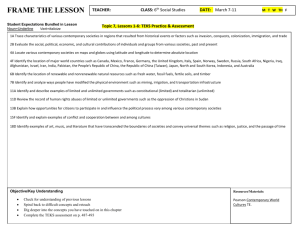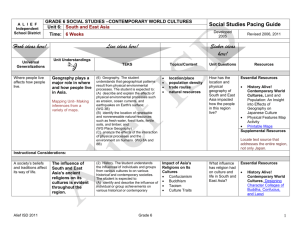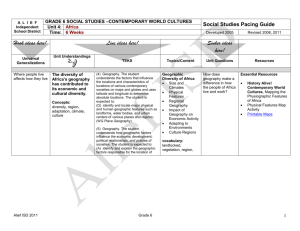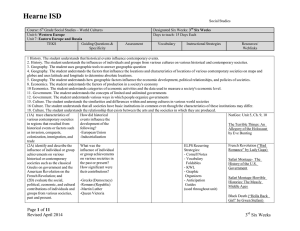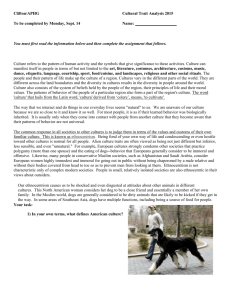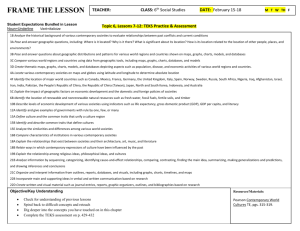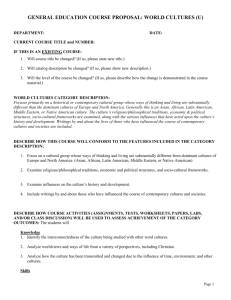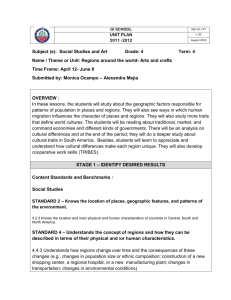(1)In bold text, Knowledge and Skill Statement
advertisement
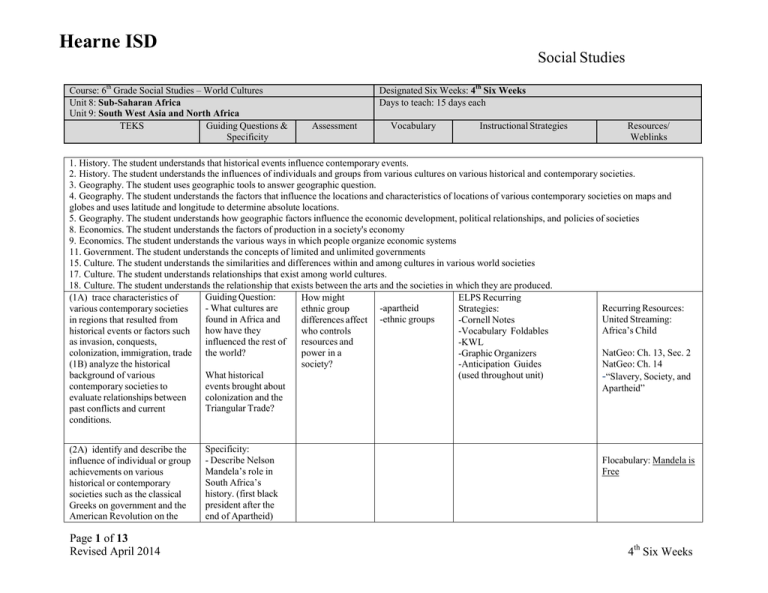
Hearne ISD Social Studies Course: 6th Grade Social Studies – World Cultures Unit 8: Sub-Saharan Africa Unit 9: South West Asia and North Africa TEKS Guiding Questions & Specificity Designated Six Weeks: 4th Six Weeks Days to teach: 15 days each Assessment Vocabulary Instructional Strategies Resources/ Weblinks 1. History. The student understands that historical events influence contemporary events. 2. History. The student understands the influences of individuals and groups from various cultures on various historical and contemporary societies. 3. Geography. The student uses geographic tools to answer geographic question. 4. Geography. The student understands the factors that influence the locations and characteristics of locations of various contemporary societies on maps and globes and uses latitude and longitude to determine absolute locations. 5. Geography. The student understands how geographic factors influence the economic development, political relationships, and policies of societies 8. Economics. The student understands the factors of production in a society's economy 9. Economics. The student understands the various ways in which people organize economic systems 11. Government. The student understands the concepts of limited and unlimited governments 15. Culture. The student understands the similarities and differences within and among cultures in various world societies 17. Culture. The student understands relationships that exist among world cultures. 18. Culture. The student understands the relationship that exists between the arts and the societies in which they are produced. Guiding Question: (1A) trace characteristics of How might ELPS Recurring - What cultures are -apartheid Recurring Resources: various contemporary societies ethnic group Strategies: found in Africa and United Streaming: in regions that resulted from differences affect -ethnic groups -Cornell Notes how have they Africa’s Child historical events or factors such who controls -Vocabulary Foldables influenced the rest of as invasion, conquests, resources and -KWL NatGeo: Ch. 13, Sec. 2 colonization, immigration, trade the world? power in a -Graphic Organizers NatGeo: Ch. 14 -Anticipation Guides (1B) analyze the historical society? What historical (used throughout unit) background of various -“Slavery, Society, and events brought about contemporary societies to Apartheid” colonization and the evaluate relationships between Triangular Trade? past conflicts and current conditions. (2A) identify and describe the influence of individual or group achievements on various historical or contemporary societies such as the classical Greeks on government and the American Revolution on the Page 1 of 13 Revised April 2014 Specificity: - Describe Nelson Mandela’s role in South Africa’s history. (first black president after the end of Apartheid) Flocabulary: Mandela is Free 4th Six Weeks Hearne ISD Social Studies Course: 6th Grade Social Studies – World Cultures Unit 8: Sub-Saharan Africa Unit 9: South West Asia and North Africa TEKS Guiding Questions & Specificity French Revolution (2B) evaluate the social, political, economic, cultural contributions of individuals groups from various societies, past and present. (3A) pose and answer geographic questions, including: Where is it located? Why is it there? What is significant about its location? How is its location related to the location of other people, places, and environments? (3B) pose and answer questions about geographic distributions and patterns for various world regions and countries shown on maps, graphs, charts, models, and (3C) compare various world regions and countries using data from geographic tools, including maps, graphs, charts, databases, and models; databases. (4D) identify and locate major physical and human geographic features such as landforms, water bodies, and urban centers of various places and regions. Page 2 of 13 Revised April 2014 Guiding Question: -How does the geography differ across the continent? Guiding Question: - What are the major geographic features of Africa? Such as… - Mt. Kilimanjaro Designated Six Weeks: 4th Six Weeks Days to teach: 15 days each Assessment •Compare and contrast world regions based on climate, culture, and location factors (e.g. latitude, longitude, and equator) or environmental factors Describe the way rivers change as they flow across Earth’s surface? Vocabulary - refugee - subsistence Farming -drought -famine -indigenous -nomad Instructional Strategies Resources/ Weblinks Discovery StreamingAfrica People & Places NatGeo: Ch. 13, Sec. 1 -“World Geography: Africa” -“Africa Today” -“Horn of Africa” -“Africa: People and Places” -“Regions of the World: Africa” -Africanisms PPT Nystrom-Lesson 1, 2 Pgs. 41-44 4th Six Weeks Hearne ISD Social Studies Course: 6th Grade Social Studies – World Cultures Unit 8: Sub-Saharan Africa Unit 9: South West Asia and North Africa TEKS Guiding Questions & Specificity (4E) draw sketch maps that illustrate various places and regions. (4F) identify the location of major world countries such as… South Africa…Nigeria. (5A) identify and explain the geographic factors responsible for the location of economic activities in places and regions. - Lake Victoria - Horn of Africa - Sahara Desert - Sahel - Savanna - Kalahari Desert Guiding Question: - How have geographical features affected the way people live and make their living? (8A) describe ways in which the factors of production (natural resources, labor, capital, and entrepreneurs) influence the economies of various. (8B) identify problems and issues that may arise when one or more of the factors of production is in relatively short supply; (8C) explain the impact of relative scarcity of resources on international trade and economic interdependence among and within societies. Specificity: - Give examples of major industries and explain how geography and the factor of production help determine their location. Page 3 of 13 Revised April 2014 What are problems and issues that arise when one or more of the factors of production are in short supply? How do war and political unrest continue to keep African countries from having enough Designated Six Weeks: 4th Six Weeks Days to teach: 15 days each Assessment Vocabulary Instructional Strategies Resources/ Weblinks Explain ways in which people adapt to living in a desert region? Discovery EducationAfrica’s Child Series How are women microentrepreneurs in developing countries changing their communities? www.Africam.com NatGeo: Ch. 14, Sec. 2 Nystrom-Lesson 3 Select three women microentrepreneurs to study and learn how they are changing the human characteristics of their African communities. 4th Six Weeks Hearne ISD Social Studies Course: 6th Grade Social Studies – World Cultures Unit 8: Sub-Saharan Africa Unit 9: South West Asia and North Africa TEKS Guiding Questions & Specificity Designated Six Weeks: 4th Six Weeks Days to teach: 15 days each Assessment Vocabulary Instructional Strategies Resources/ Weblinks capital, entrepreneurs, etc.? What is the impact of relative scarcity of resources on international trade and economic interdependence among and within societies? (9B) compare and contrast free enterprise, socialist, and communist economies in various contemporary societies, including the benefits of the U.S. free enterprise system. (11A) identify and describe examples of limited and unlimited governments such as constitutional (limited) and totalitarian (unlimited). (11B) compare the characteristics of limited and unlimited governments. (15C) define a multicultural society and consider both the positive and negative qualities of multiculturalism. (15D) analyze the experiences and evaluate the contributions of diverse groups to multicultural societies. Page 4 of 13 Revised April 2014 www.culturegrams.com www.cia.gov Specificity: - Give examples of movement toward democracy in South Africa. www.CountryReports.o rg Guiding Question: - How has African culture influenced American culture? -“South Africa: A Land Apart” -Africa PPT www.CountryWatch.co m 4th Six Weeks Hearne ISD Social Studies Course: 6th Grade Social Studies – World Cultures Unit 8: Sub-Saharan Africa Unit 9: South West Asia and North Africa TEKS Guiding Questions & Specificity (17C) evaluate the impact of improved communication technology among cultures. Designated Six Weeks: 4th Six Weeks Days to teach: 15 days each Assessment Vocabulary Instructional Strategies Resources/ Weblinks What is the impact of cultural diffusion on individuals and world societies? (17D) identify and define the impact of cultural diffusion on individuals and world societies; (18B) relate ways in which contemporary expressions of culture have been influenced by the past; How have www.playingforchange. contemporary com expressions of culture been influenced by the past? •Music—call and response, drums •Storytelling—griot African mask project tradition •Literature—Chinua Achebe (Nigeria), Bessie Head (Botswana) •Masks in Traditional /Modern African Art •Textiles—Kente cloth (Ghana) 1. History. The student understands that historical events influence contemporary events 2. History. The student understands the influences of individuals and groups from various cultures on various historical and contemporary societies 3. Geography. The student uses geographic tools to answer geographic questions 4. Geography. The student understands the factors that influence the locations and characteristics of locations of various contemporary societies on maps and globes and uses latitude and longitude to determine absolute locations 5. Geography. The student understands how geographic factors influence the economic development, political relationships, and policies of societies 6. Geography. The student understands that geographical patterns result from physical environmental processes 7. Geography. The student understands the impact of interactions between people and the physical environment on the development and conditions of places and Page 5 of 13 Revised April 2014 4th Six Weeks Hearne ISD Social Studies Course: 6th Grade Social Studies – World Cultures Unit 8: Sub-Saharan Africa Unit 9: South West Asia and North Africa TEKS Guiding Questions & Specificity Designated Six Weeks: 4th Six Weeks Days to teach: 15 days each Assessment Vocabulary Instructional Strategies regions. 8. Economics. The student understands the factors of production in a society's economy. 10. Economics. The student understands categories of economic activities and the data used to measure a society's economic level 11. Government. The student understands the concepts of limited and unlimited governments 12. Government. The student understands various ways in which people organize governments 15. Culture. The student understands the similarities and differences within and among cultures in various world societies 17. Culture. The student understands relationships that exist among world cultures. 19. Culture. The student understands the relationships among religion, philosophy, and culture. 20. Science, technology, and society. The student understands the influences of science and technology on contemporary societies 3D) create thematic maps, Where is it located? Mapping Activity graphs, charts, models, and Why is it there? What Countries databases depicting aspects is significant about its Saudi Arabia such as population, disease, and location? How is its Egypt economic activities of various location related to the Israel/Palestine world regions and countries. location of other Iraq people, places, and Iran environments? Morocco 4D) identify and locate major Turkey physical and human geographic Tunisia features such as landforms, Afghanistan water bodies, and urban centers Libya of various places and regions; Algeria 4E) draw sketch maps that illustrate various places and regions 4F) identify the location of major world countries such as Canada, Mexico, France, Germany, the United Kingdom, Italy, Spain, Norway, Sweden, Russia, South Africa, Nigeria, Page 6 of 13 Revised April 2014 Landforms Sahara Arabian Peninsula Resources/ Weblinks Safari Montage- Fossil Fuels -“Middle East: Land of Contrast” -“Egypt” -“Iran: Behind the Veil” Nystrom-Middle East activities Bodies of Water Red Sea Nile River Tigris River Euphrates River Mediterranean Sea 4th Six Weeks Hearne ISD Social Studies Course: 6th Grade Social Studies – World Cultures Unit 8: Sub-Saharan Africa Unit 9: South West Asia and North Africa TEKS Guiding Questions & Specificity Designated Six Weeks: 4th Six Weeks Days to teach: 15 days each Assessment Vocabulary Iraq, Afghanistan, Israel, Iran, India, Pakistan, the People's Republic of China, the Republic of China (Taiwan), Japan, North and South Korea, Indonesia, and Australia Resources/ Weblinks Suez Canal Persian Gulf Arabian Sea Caspian Sea 4B) identify and explain the geographic factors responsible for patterns of population in places and regions What geographic factors are responsible for patterns of population in places and regions? 1A) trace characteristics of various contemporary societies in regions that resulted from historical events or factors such as invasion, conquests, Specificity: -Describe the events and factors leading up to: - Arab trade and Page 7 of 13 Revised April 2014 Instructional Strategies -Describe the rules and laws of Saudi Arabia. - monotheism - terrorism - prophet - pilgrimage - belief systems Characteristics Religion (Official religions of countries, Shia and Sunni Natural resources: oil and water Population density (focus on coasts, deserts and Nile) Identify the effects on population patterns from: Resources - natural (water) - infrastructure Climate Landforms -barriers (mountains, desert, etc.) - accessibility (water and other transportation corridors)—good place to identify chokepoints for oil transport ELPS Recurring Strategies: -Cornell Notes -Vocabulary Foldables NatGeo : Ch. 15, Sec. 1, 3 Contemporary World Cultures, Jews and Palestinians: Two Claims to Palestine 4th Six Weeks Hearne ISD Social Studies Course: 6th Grade Social Studies – World Cultures Unit 8: Sub-Saharan Africa Unit 9: South West Asia and North Africa TEKS Guiding Questions & Specificity colonization, immigration, and trade 1B) analyze the historical background of various contemporary societies to evaluate relationships between past conflicts and current conditions 2A) identify and describe the influence of individual or group achievements on various historical or contemporary societies such as the classical Greeks on government and the American Revolution on the French Revolution Designated Six Weeks: 4th Six Weeks Days to teach: 15 days each Assessment Vocabulary conquests - the Arab-Israeli conflict. Instructional Strategies -KWL -Graphic Organizer s -Anticipation Guides Specificity: - Identify and describe the contributions of Ancient Mesopotamia ; Jews, Christians, and Muslims Resources/ Weblinks NatGeo: Ch. 15, Sec. 2; Ch. 16, Sec. 1, 2 Discovery EducationMesopotamia: From Nomads to Farmers Flocabulary: The Fertile Crescent TCI: World Cultures Alive: Understanding Major Religions in Southwest Asia -“Religions of the World: Christianity” -“Religions of the World: Islam” -“Religions of the World: Judaism” -“Living History: Life in Ancient Egypt” Horrible Histories (Animated) -“Awesome Egyptians” -“Trading Timbuktu” 3A) pose and answer geographic questions, including: Where is it located? Why is it there? What is significant about its location? Page 8 of 13 Revised April 2014 Where is it located? Why is it there? What is significant about its location? How is its location related to the -landlocked -fertile -scarcity Create an outline map of the Middle East and identify the countries of the region, as well as their capitals. 4th Six Weeks Hearne ISD Social Studies Course: 6th Grade Social Studies – World Cultures Unit 8: Sub-Saharan Africa Unit 9: South West Asia and North Africa TEKS Guiding Questions & Specificity How is its location related to the location of other people, places, and environments? 6B) identify the location of renewable and nonrenewable natural resources such as fresh water, fossil fuels, fertile soils, and timber 3B) pose and answer questions about geographic distributions and patterns for various world regions and countries shown on maps, graphs, charts, models, and databases; 5C) explain the impact of geographic factors on economic development and the domestic and foreign policies of societies. 7B) identify and analyze ways people have modified the physical environment such as mining, irrigation, and transportation infrastructure; 8A) describe ways in which the factors of production (natural Page 9 of 13 Revised April 2014 Designated Six Weeks: 4th Six Weeks Days to teach: 15 days each Assessment Vocabulary location of other people, places, and environments? Instructional Strategies Create a chart or graph comparing the distribution of fossil fuels in the Middle East. Resources/ Weblinks NatGeo: Ch. 16, Sec. 2 People locate themselves in relation to natural resources as well as cultural preferences. NatGeo: The Nile River Valley Pgs. 430, 431 What are the ways people have modified the environment? Why have they modified the environment? - Suez Canal and Nile’s role in irrigation Specificity: - Explain the impact -What is Israel’s economy - scarcity - agriculture Create a chart comparing the economic Safari Montage- The 4th Six Weeks Hearne ISD Social Studies Course: 6th Grade Social Studies – World Cultures Unit 8: Sub-Saharan Africa Unit 9: South West Asia and North Africa TEKS Guiding Questions & Specificity resources, labor, capital, and entrepreneurs) influence the economies of various contemporary societies 8B) identify problems and issues that may arise when one or more of the factors of production is in relatively short supply 8C) explain the impact of relative scarcity of resources on international trade and economic interdependence among and within societies 10B) describe levels of economic development of various societies using indicators such as life expectancy, gross domestic product (GDP), GDP per capita, and literacy; 11A) identify and describe examples of limited and unlimited governments such as constitutional (limited) and totalitarian (unlimited) 11B) compare the characteristics of limited and unlimited governments 12A) identify and give examples of governments with rule by one, few, or many 12B) compare ways in which Page 10 of 13 Revised April 2014 of oil production on the Middle East. Designated Six Weeks: 4th Six Weeks Days to teach: 15 days each Assessment dependent upon? In your own words explain and give an example of relative scarcity? Specificity: - Compare and contrast the varying forms of government in the Middle East. -Using a Venn diagram, compare and contrast limited and unlimited forms of government in the Middle East. Vocabulary - petroleum - GDP - life expectancy - literacy rate - per capita - economic interdependence - factors of production Instructional Strategies development of Middle Eastern societies using life expectancy, per capita GDP, and literacy. Resources/ Weblinks Middle East TCI: World Cultures Alive: How Oil has Shaped Life in Southwest Asia www.CountryReports.org www.CountryWatch.com Countries of the World ELPS Recurring Strategies: - Cornell Notes - Vocabulary Foldables - KWL chart - Graphic Organizers - Anticipations Guides www.CountryReports.org NatGeo: Ch. 16 Sec. 2 4th Six Weeks Hearne ISD Social Studies Course: 6th Grade Social Studies – World Cultures Unit 8: Sub-Saharan Africa Unit 9: South West Asia and North Africa TEKS Guiding Questions & Specificity various societies such as China, Germany, India, and Russia organize government and how they function 15A) define culture and the common traits that unify a culture region 15B) identify and describe common traits that define cultures 15F) identify and explain examples of conflict and cooperation between and among cultures. 17A) identify and describe how culture traits such as trade, travel, and war spread 17B) identify and describe factors that influence cultural change such as improved communication, transportation, and economic development 17C) evaluate the impact of improved communication technology among cultures 19A) explain the relationship among religious ideas, philosophical ideas, and cultures 19B) explain the significance of religious holidays and observances such as Christmas, Page 11 of 13 Revised April 2014 Specificity: - Identify, compare, and contrast cultural traits in the US with those in Middle East society. Designated Six Weeks: 4th Six Weeks Days to teach: 15 days each Assessment List and describe the three major religions that were established in the Middle East. What are examples of conflict and cooperation between and among cultures? - Israel/Palestine Vocabulary - trade - monotheism - prophet - pilgrimage Instructional Strategies ELPS Recurring Strategies: - Cornell Notes - Vocabulary Foldables - KWL chart - Graphic Organizers - Anticipations Guides Resources/ Weblinks TCI: World Cultures Alive: Understanding Major Religions in SW Asia - How does trade and transportation affect the country’s economy? - Describe ways in which religious ideas and values shape cultures. 4th Six Weeks Hearne ISD Social Studies Course: 6th Grade Social Studies – World Cultures Unit 8: Sub-Saharan Africa Unit 9: South West Asia and North Africa TEKS Guiding Questions & Specificity Easter, Ramadan, the annual hajj, Yom Kippur, Rosh Hashanah, Diwali, and Vaisakhi in various contemporary societies 20B) explain how resources, belief systems, economic factors, and political decisions have affected the use of technology; Page 12 of 13 Revised April 2014 How have resources, belief systems, economic factors, and political decisions affected the use of technology? - Afghanistan - Taliban - Al Qaeda Designated Six Weeks: 4th Six Weeks Days to teach: 15 days each Assessment Vocabulary - Belief systems include the beliefs and values shared by members of a racial, ethnic, or social group as well as those held by individuals. Instructional Strategies Resources/ Weblinks Discussions items: - Belief systems develop over time and reflect the ideology, religion, politics, social structure, and economic activities of a particular group. - Economic factors include the cost of design and development, construction, and operation, the access to essential resources of materials and knowledge, capital accumulation, investment needs, and proximity of supply lines and transportation routes to raw materials and potential consumers. Political decisions include decisions made by the government that are made to support the ideology of the government and/or the good of the citizens as a group. How does the government spend its 4th Six Weeks Hearne ISD Social Studies Course: 6th Grade Social Studies – World Cultures Unit 8: Sub-Saharan Africa Unit 9: South West Asia and North Africa TEKS Guiding Questions & Specificity Designated Six Weeks: 4th Six Weeks Days to teach: 15 days each Assessment Vocabulary Instructional Strategies Resources/ Weblinks money? Military rather than on the people, infrastructure and education? Page 13 of 13 Revised April 2014 4th Six Weeks

